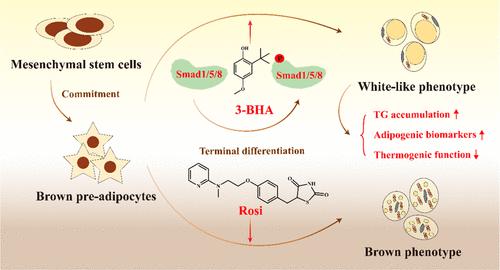当前位置:
X-MOL 学术
›
Environ. Sci. Technol.
›
论文详情
Our official English website, www.x-mol.net, welcomes your
feedback! (Note: you will need to create a separate account there.)
3-tert-Butyl-4-hydroxyanisole Perturbs Differentiation of C3H10T1/2 Mesenchymal Stem Cells into Brown Adipocytes through Regulating Smad Signaling
Environmental Science & Technology ( IF 10.8 ) Pub Date : 2023-07-23 , DOI: 10.1021/acs.est.3c02346 Xiaoyun Wang 1, 2 , Zhendong Sun 3 , Yao Pei 1, 2 , Qian S Liu 1 , Qunfang Zhou 1, 2, 3 , Guibin Jiang 1, 2, 3
Environmental Science & Technology ( IF 10.8 ) Pub Date : 2023-07-23 , DOI: 10.1021/acs.est.3c02346 Xiaoyun Wang 1, 2 , Zhendong Sun 3 , Yao Pei 1, 2 , Qian S Liu 1 , Qunfang Zhou 1, 2, 3 , Guibin Jiang 1, 2, 3
Affiliation

|
3-tert-Butyl-4-hydroxyanisole (3-BHA), one of the most commonly used antioxidants in foodstuffs, has been identified as an environmental endocrine disruptor (EED) with obesogenic activity. Given the increasing concern on EED-caused dysfunction in lipid metabolism, whether 3-BHA could influence the development of brown adipocytes is worthy of being explored. In this study, the effect of 3-BHA on the differentiation of C3H10T1/2 mesenchymal stem cells (MSCs) into brown adipocytes was investigated. Exposure to 3-BHA promoted lipogenesis of the differentiated cells, as evidenced by the increased intracellular lipid accumulation and elevated expressions of adipogenic biomarkers, including peroxisome proliferator-activated receptor γ (PPARγ), Perilipin, Adiponectin, and fatty acid binding protein 4 (FABP4). Surprisingly, the thermogenic capacity of the differentiated cells was compromised as a result of 3-BHA exposure, because neither intracellular mitochondrial contents nor expressions of thermogenic biomarkers, including uncoupling protein 1 (UCP1), peroxisome proliferator-activated receptor γ coactivator 1α (PGC1α), cell-death-inducing DNA fragmentation factor α subunit-like effector A (CIDEA), and PR domain containing 16 (PRDM16), were increased by this chemical. The underlying molecular mechanism exploration revealed that, in contrast to p38 MAPK, 3-BHA stimulation induced phosphorylation of Smad1/5/8 in an exposure time-dependent manner, suggesting that this chemical-triggered Smad signaling was responsible for the shift of C3H10T1/2 MSC differentiation from a brown to white-like phenotype. The finding herein, for the first time, revealed the perturbation of 3-BHA in the development of brown adipocytes, uncovering new knowledge about the obesogenic potential of this emerging chemical of concern.
中文翻译:

3-叔丁基-4-羟基苯甲醚通过调节 Smad 信号传导干扰 C3H10T1/2 间充质干细胞向棕色脂肪细胞的分化
3-叔丁基-4-羟基苯甲醚 (3-BHA) 是食品中最常用的抗氧化剂之一,已被确定为具有致肥胖活性的环境内分泌干扰物 (EED)。鉴于人们越来越关注 EED 引起的脂质代谢功能障碍,3-BHA 是否会影响棕色脂肪细胞的发育值得探讨。在本研究中,研究了3-BHA对C3H10T1/2间充质干细胞(MSC)分化为棕色脂肪细胞的影响。暴露于 3-BHA 促进了分化细胞的脂肪生成,细胞内脂质积累增加和脂肪形成生物标志物表达升高证明了这一点,包括过氧化物酶体增殖物激活受体 γ ( PPARγ )、Perilipin 、脂联素和脂肪酸结合蛋白4 ( FABP4 ))。令人惊讶的是,分化细胞的生热能力因 3-BHA 暴露而受到损害,因为细胞内线粒体含量和生热生物标志物的表达均不表达,包括解偶联蛋白 1 ( UCP1 )、过氧化物酶体增殖物激活受体 γ 共激活物1α ( PGC1α )这种化学物质可增加细胞死亡诱导 DNA 碎片因子 α 亚基样效应子 A ( CIDEA ) 和 PR 结构域包含 16 ( PRDM16 ) 的含量。潜在的分子机制探索表明,与 p38 MAPK 相比,3-BHA 刺激以暴露时间依赖性方式诱导 Smad1/5/8 磷酸化,表明这种化学触发的 Smad 信号传导导致了 C3H10T1/ 的转变。图2 MSC从棕色表型分化为白色样表型。本文的发现首次揭示了 3-BHA 对棕色脂肪细胞发育的干扰,揭示了有关这种新兴化学物质致肥胖潜力的新知识。
更新日期:2023-07-23
中文翻译:

3-叔丁基-4-羟基苯甲醚通过调节 Smad 信号传导干扰 C3H10T1/2 间充质干细胞向棕色脂肪细胞的分化
3-叔丁基-4-羟基苯甲醚 (3-BHA) 是食品中最常用的抗氧化剂之一,已被确定为具有致肥胖活性的环境内分泌干扰物 (EED)。鉴于人们越来越关注 EED 引起的脂质代谢功能障碍,3-BHA 是否会影响棕色脂肪细胞的发育值得探讨。在本研究中,研究了3-BHA对C3H10T1/2间充质干细胞(MSC)分化为棕色脂肪细胞的影响。暴露于 3-BHA 促进了分化细胞的脂肪生成,细胞内脂质积累增加和脂肪形成生物标志物表达升高证明了这一点,包括过氧化物酶体增殖物激活受体 γ ( PPARγ )、Perilipin 、脂联素和脂肪酸结合蛋白4 ( FABP4 ))。令人惊讶的是,分化细胞的生热能力因 3-BHA 暴露而受到损害,因为细胞内线粒体含量和生热生物标志物的表达均不表达,包括解偶联蛋白 1 ( UCP1 )、过氧化物酶体增殖物激活受体 γ 共激活物1α ( PGC1α )这种化学物质可增加细胞死亡诱导 DNA 碎片因子 α 亚基样效应子 A ( CIDEA ) 和 PR 结构域包含 16 ( PRDM16 ) 的含量。潜在的分子机制探索表明,与 p38 MAPK 相比,3-BHA 刺激以暴露时间依赖性方式诱导 Smad1/5/8 磷酸化,表明这种化学触发的 Smad 信号传导导致了 C3H10T1/ 的转变。图2 MSC从棕色表型分化为白色样表型。本文的发现首次揭示了 3-BHA 对棕色脂肪细胞发育的干扰,揭示了有关这种新兴化学物质致肥胖潜力的新知识。


















































 京公网安备 11010802027423号
京公网安备 11010802027423号